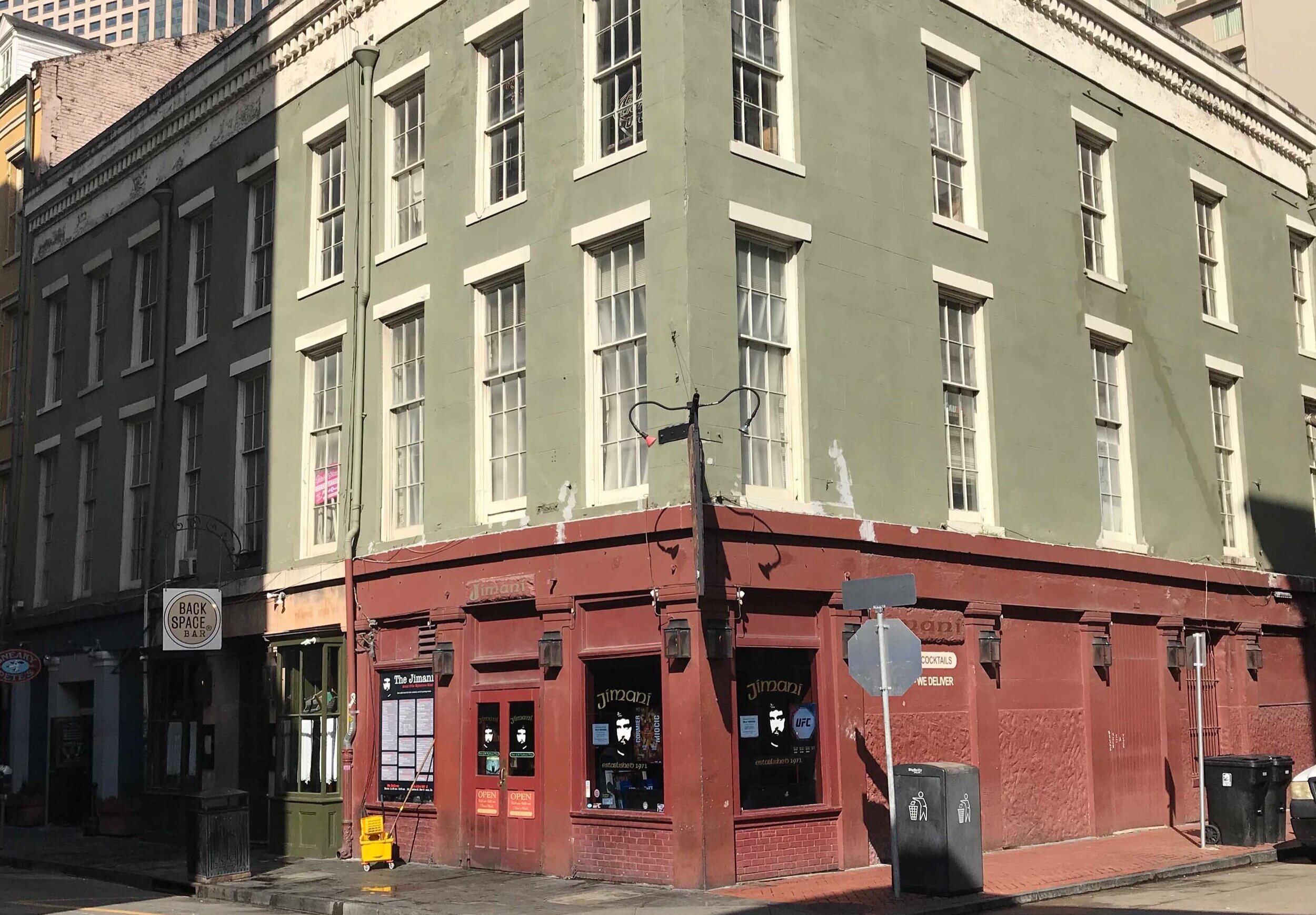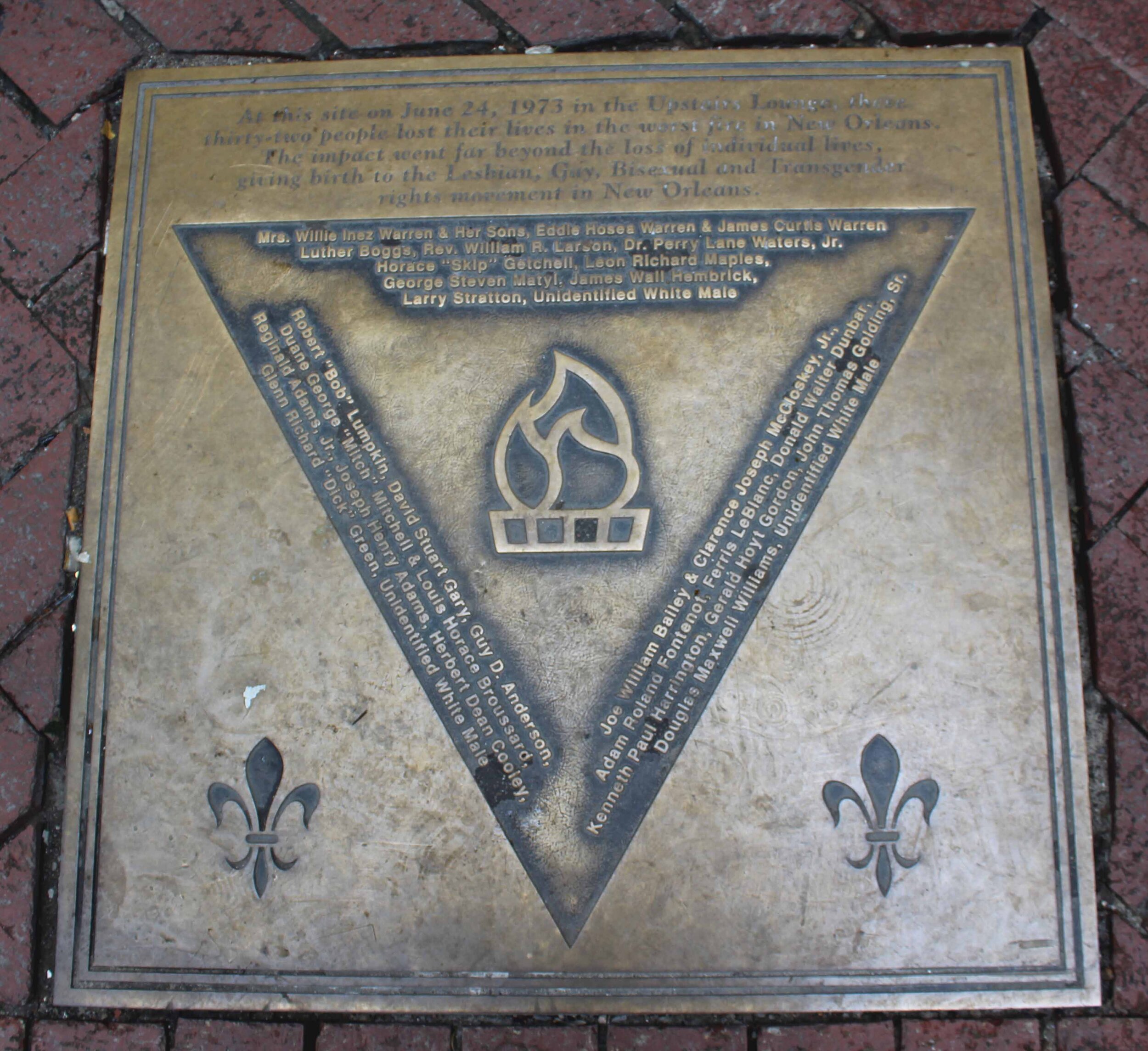Almost 50 years later, deadly attack at New Orleans gay bar remains unsolved
This 2019 photo shows the site of where the Up Stairs Lounge was located. Wikipedia
By Lane Craft and Macy Weaver
Mississippi Center For Investigative Reporting
A fireball rushed inside the Up Stairs Lounge and raced through the bar, and the flammable decor and patrons’ polyester clothing.
Those trapped inside desperately tried to squeeze through the iron bars on the floor-to-ceiling windows. Firefighters found grisly spectacles: a dead man hanging from one window with horror seared on his face and, upstairs, piles of charred bodies, some melted together. The smell of burnt flesh was overwhelming.
By the time the flames were extinguished, 32 people were dead. It had been the worst fire in New Orleans’ history. But because the Up Stairs Lounge was a gay bar and all but one of the dead were gay men, the police investigation of the arson was casual and incomplete. No one was ever charged. The crime remained unsolved.
The death toll from that June 24, 1973, arson -- the deadliest crime against gays in the U.S. -- was a piece of history forgotten on June 12, 2016. That’s when, during national Gay Pride week, the death toll was surpassed at Pulse, a gay bar in Orlando, Florida. A Sunday “beer bust” always marks the week’s end and the close of the day of worship. Working class people -- including some straight and some female -- gather from 5 p.m. to 7 p.m. and drink as much beer as they want for just a dollar. Before police fatally shot him, the gunman had killed 49 Pulse patrons and injured 53.
A plaque in the sidewalk at the former entrance to Up Stairs Lounge in New Orleans commemorates the victims of an arson attack on the gay bar on June 24, 1973. MacKenzie Moffat, MCIR Justice Squad
But the Up Stairs Lounge arson in 1973 occurred before there was a national gay pride day, week or month, and when homosexual activity was a crime. Today, a brass plaque with the names of the 32 dead is embedded in the sidewalk in front of what used to be the entrance from Iberville Street to the staircase leading to the second-floor lounge. According to New Orleans author and tour guide Frank Perez, the staircase remains charred from the blaze.
A Night to Remember
The evening of June 24, 1973, began like any other Sunday night at the Up Stairs Lounge, at the edge of the French Quarter a couple of blocks from Canal Street. This friendly, neighborhood gay community bar hesitated to live or socialize openly. The Up Stairs Lounge was a place they could relax.
The camaraderie was bolstered by the weekly attendance of at least a few members of the nearby Metropolitan Community Church -- a local branch of a national church that ministers to gays. Until the church found other space, it held services in the theater in the back of the Up Stairs Lounge. The bar had a piano and sing-alongs, usually of Broadway tunes, and church goers often led the bar patrons in a series of hymns.
At 7 p.m., toward the end of the beer bust, remnants of the bar crowd gathered around the piano, held hands in a circle, and sang the Brotherhood of Man’s hit, United We Stand. The 1969 Stonewall riots in New York’s Greenwich Village had launched the national gay pride movement, but it had yet to reach New Orleans. Singing United We Stand was the closest any regular at Up Stairs Lounge got to gay solidarity.
By 7:56 p.m., the beer bust crowd had thinned to around 60 people. When patron Luther Boggs opened the heavy metal fire door at the bar’s entrance, he found the staircase engulfed in flames. The fire burst inside.
Bartender Buddy Rasmussen managed to lead more than 20 patrons out the back exit to a rooftop. The rest tried unsuccessfully to squeeze through the scalding-hot iron bars. Firefighters and emergency medical personnel found one dead man hanging from a window and upstairs, many more dead.
The fire was extinguished in mere minutes, the last flame put out at 8:12 p.m. Among the casualties were 32 dead -- three of them white males who remain unidentified -- and 15 injured. A third of the Metropolitan Community Church’s congregation had died, along with the pastor.
The office of the powerful, charismatic archbishop of New Orleans, Philip Hannan, forbade any memorial for victims in New Orleans’ St. Louis Cathedral. But although the suspected arsonist committed suicide, he did receive a Catholic funeral in his hometown in south Louisiana. His headstone stands there on consecrated ground.
Gay New Orleans, 1973
Today, gay men may not feel judged entering a gay bar. But in the 1970s, they felt vulnerable and exposed -- much safer inside the bar among their own. Gay men kept each other’s secret of being gay, so they leaned on each other. In their close-knit community, they took friends to medical appointments and even bailed them out of jail.
In the 1970s, New Orleans was about 60 percent Catholic, in a state where it remains the largest religious denomination. Since the Roman Catholic church and most Christian denominations oppose homosexuality, the general atmosphere in New Orleans was very hostile towards gays. Clayton Delery-Edwards, a retired teacher who lives in New Orleans, highlights Louisiana’s homophobic, sexist and racist state of mind at the time of the fire in his book The Up Stairs Lounge Arson: 32 Deaths in a New Orleans Gay Bar, June 24,1973.
Robert W. Fieseler is the author of Tinderbox: The Untold Story of the Up Stairs Lounge Fire and the Rise of Gay Liberation. Photo courtesy of rwfieseler.com
New Orleans aficionado Robert W. Fieseler, author of Tinderbox: The Untold Story of the Up Stairs Lounge Fire and the Rise of Gay Liberation, said in an interview that in 1973, if you accused someone of being queer at a time when queer was “a bad word, even a ‘killing’ word, you could expect a very violent encounter.”
If a man announced publicly he was gay, Fieleser said, he was shunned by his biological family and his chosen family of gay friends, who were afraid of losing their jobs. (At the time, only New York City and San Francisco had legal employment protections for gays.) Fieseler explained that there were more survivors of the Up Stairs Lounge fire than the names that appeared on the official list. Some survivors immediately ran away for fear of being recognized or photographed and outed because of their association with the bar.
Former bartender Buddy Rasmussen now lives in remote rural Arkansas and does not give interviews, possibly due to the traumatic nature of the event and the loss of his then-lover who died in the fire. Other survivors, including Ricky Everett, are eager to tell the story of the Upstairs Lounge fire. Everett appears in Robert L. Camina’s documentary, UpStairs Inferno. Everett takes a very religious approach, hoping to convince others that God doesn’t hate anyone because of sexual orientation.
Author Fieseler describes 1973 New Orleans as mask-wearing, figuratively and literally. Whether you were gay or straight, if you remained discreet, showed up at church on Sundays, and wore the mask of a God-fearing Christian, your homosexual behavior, illegal gambling, mafia involvement, drug use or prostitution would be tolerated, Fieseler says.
At the same time, according to Fieseler, any type of gender difference was not well understood, and attitudes blurred it with dangerous behavior such as pedophilia and even terrorism. Gay people were not immune from such attitudes, especially those who were confused about or unsure of their own gender differences.
People like Roger Dale Nunez, then 26.
Prime Suspect
Nunez had left his small home town of Abbeville in southwest Lousiana’s Cajun bayous for the freer air of the supposed Big Easy and supported himself as a gay hustler. He took dilantin for his epilepsy and was not supposed to drink, but he was a heavy drinker. He also had spent time in a state mental hospital around 1970.
Fieseler writes that several surviving witnesses attested that Nunez arrived in the Up Stairs Lounge early in the evening of June 24. He was very drunk. At another bar, he had demanded that a barmaid break $20 into smaller bills for him; she complied.
Around 7:30 pm, the Up Stairs Lounge evicted Nunez for hustling, which the community and family-friendly bar did not allow, and for starting a fight. Two witnesses say they heard Nunez yell something like, “I’m going to burn you all out,” or “I’m going to burn this place to the ground.” Both men heard the word “burn,” despite the noise in the bar.
Down the street from the Up Stairs Lounge, at a Walgreen’s that still stands on the corner of Iberville and Royal, a clerk identified Nunez as the White man in his mid-20s, heavily drunk and emotionally upset, who bought a 7-ounce can of Ronsonol lighter fluid on the evening of June 24.
No one saw who, but someone poured lighter fluid onto the left side of the second step of the carpeted staircase leading up to the bar and dropped the can. The arsonist also dropped two $10 bills, probably while groping for a match book or a lighter. Firefighters found the can and the bills and collected them to check for fingerprints.
The night of June 24, Fieseler writes, a soot-covered Nunez remained on Iberville Street, watching the fire. Around 8:30 p.m., Rasmussen and another survivor spotted him and tried to get a policeman to detain him for questioning because of the ruckus he had caused in the bar earlier. They couldn’t convince the officer. They tried a lieutenant, who also rebuffed them. In 1973 New Orleans, no police officer considered a gay man a reliable witness.
“Few -- if any -- policemen in American had received official guidance for investigating gay crimes...Nor had the officers been briefed on up-to-date studies for ‘pathological firesetting’...As a result, they didn’t know that the desire for revenge was what made a so-called firesetter snap in more than one quarter of such cases,” Fieseler writes. “Nuanced concepts such as homophobia, internalized self-hatred, or even the closet were absolutely foreign to them -- for [gays] were a law-breaking group with whom their profession spurned relations. Law enforcement officers [in Louisiana] could in fact be punished for simply knowing a gay person.”
As Fieseler documents, police investigation of the Up Stairs Lounge fire was very casual. Eventually Nunez was interviewed, but never charged. Records of the investigation were lost in flooding caused by Hurricane Katrina in 2005. The Ronsonol can and two half-burnt $10 bills investigators had found in 1973 were contaminated during Katrina’s flooding.
The New Orleans Fire Department did not point out a suspect. Police closed the file on the case. No one was charged. The fire marshal's office also investigated and concluded Nunez was the prime suspect. But the police did not follow up.
A few months after the fire, Nunez married a much older woman. In the year after the fire, he confided in a nun and drunkenly admitted to two friends on separate occasions that he was responsible for the fire. One friend told historian Johnny Townsend that Nunez said he “just wanted to scare people” and never meant to kill anyone. For various reasons, Fieseler reports, none of his confidants went to the police.
In November 1974, Nunez committed suicide with a concoction of his epilepsy medication and barbiturates. Although Nunez may have been burdened with guilt -- and perhaps could be considered the 33rd person to die from the fire -- he also had a brain tumor, Delery-Edwards said. His body was sent to Abbeville, where his family made sure he was given a Catholic funeral and burial. Delery-Edwards’ book includes a photo of Nunez’s headstone.
Silence in the Cathedral
After the fire, survivors struggled to find a church that would hold a memorial for the victims, preferably in the French Quarter. The Metropolitan Community Church’s space held fewer than 20 people.
Three Catholic priests had shown up at the scene of the fire and granted “conditional absolution” over more than 20 body bags. At least two more priests had tended to those who arrived in the Accident Emergency Room at New Orleans’ Charity Hospital. But neither those priests nor Archbishop Hannan made any public statement about the Up Stairs Lounge fire, or offered condolences to the victims’ families. At the time, Fieseler reports, one anonymous priest was quoted in a local paper, “We’ll bury [any Catholic victims.] But that’s all.”
According to Johnny Townsend, author of Let the Faggots Burn: The Up Stairs Lounge Fire, one Catholic victim was given a brief funeral service in his hometown, Ville Platte, Louisiana. During the service, the priest decried the man’s homosexuality. He was buried in a community burial ground, not in the Catholic cemetery.
The late Archbishop Philip Hannan
Hannan’s autobiography, The Archbishop Wore Combat Boots, details how he championed desegregation, Vietnamese refugees and public housing in New Orleans. He also describes the 1972 fire at New Orleans’ Rault Center, which killed six people. The city declared a day of mourning. In the New Orleans Times-Picayune, Hannan offered fulsome sympathies to the bereaved families.
His memoir also describes a standoff, six weeks later, between a gunman and police at a Howard Johnson’s. He offered to mediate a hostage exchange, and spent nine hours at Charity Hospital comforting survivors and families. Ten people died, and Hannan conducted a funeral Mass for two of them. But in late June 1973, Fieseler reports, when gay leaders called the archbishop’s office to ask for a consecrated space for a memorial, a subordinate denied their requests and refused to allow them to speak to Hannan. Along with Louisiana Gov. Edwin Edwards and New Orleans Mayor Moon Landrieu, Hannan remained silent.
Fieseler’s book describes the end of a regular column in a parishioners' newspaper that Hannan wrote on July 19, nearly a month after the fire. In four sentences, the archbishop finally said, “we offer prayers for the repose of the souls of the victims and the consolation of their bereaved families and friends.” Because of the publication, and the fact Hannan’s words were unexpected, his statement received little attention.
The Up Stairs Lounge fire, Fieseler writes, ignited gay activism in New Orleans. In later years, he reports, gay activists asked Hannan to apologize for his silence after the fire. Hannan, Fieseler writes, denied his silence and blamed a subordinate “who thought he knew my mind” for the refusal to make St. Louis Cathedral available for a memorial.
Frank Perez is the author of numerous books about New Orleans history and culture. Photo courtesy of frenchquarterfrank.com
Archbishop Hannan died in 2011. In June 2013, the 40th anniversary of the Up Stairs Lounge fire, Time magazine asked New Orleans Archbishop Gregory Aymond about the church’s actions in 1973. The archbishop responded by email: “In retrospect, if we did not release a statement, we should have, to be in solidarity with the victims and their families. The church does not condone violence and hatred. If we did not extend our care and condolences, I deeply apologize.”
Frank Perez, author of numerous books about New Orleans history and culture, said if someone wanted to attack a gay bar for religious reasons, the Up Stairs Lounge, with its relaxed working class atmosphere, would not have been the first choice: “I mean, people would bring their kids!”
Perez (a.k.a. French Quarter Frank), whose most recent book is In Exile: The History and Lore Surrounding New Orleans Gay Culture and Its Oldest Gay Bar, said he thinks a homophobic killer would be more likely to attack a prominent cruising spot like Café Lafitte in the heart of the French Quarter, rather than a place focused on camaraderie like the Up Stairs Lounge.
In the 1970s, Perez said, Café Lafitte had a blowjob corner and banned women and Blacks. The Up Stairs Lounge welcomed everyone except hustlers.
Cafe Lafitte in Exile still exists, but in a new location in the French Quarter.
Today’s Up Stairs Lounge
Although the Up Stairs Lounge never reopened, visitors to New Orleans can find the same welcoming atmosphere. Fieseler says that Vaughns in the Bywater and the Golden Lantern serve as modern-day working-class gay bars that feel egalitarian and friendly.
“If you’re nice to her,” Perez says of the French Quarter, “she’ll be nice to you.” Perez gives tour guides of gay landmarks in the French Quarter, including apartments where William Faulkner and Tennesse Williams had lived. He is working on a biography of a primary figure in the Upstairs Lounge story, patron and activist Stewart Butler, who died in 2020, leaving copious journals.
At the Golden Lantern in March 2021, groups of men and families sat around the tables outside, chatting and enjoying the sunshine. A parade of gay men in wedding dresses as “the Brides of March” arrived, and began ordering drinks from the Black trans bartender. They happily posed for photos.
The 45th Anniversary Memorial Procession in New Orleans marks the deadly arson attack on the Up Stairs Lounge. Wikipedia
This story was produced by the Mississippi Center for Investigative Reporting, a nonprofit news organization that seeks to inform, educate and empower Mississippians in their communities through the use of investigative journalism. Lane Craft and Macy Weaver are 2021 members of the MCIR Justice Squad for undergraduates interested in investigative reporting. They both are rising sophomores at Millsaps College in Jackson.
Sign up for our newsletter.






